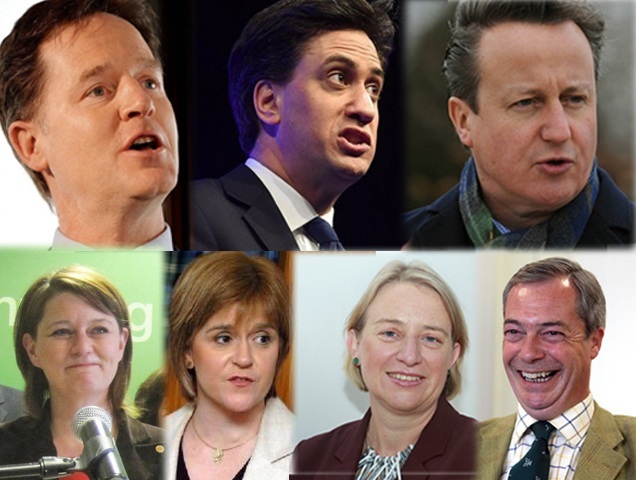The rise of Britain’s nationalist parties appeared on course to continue in the wake of last night’s landmark election debate.
Nigel Farage, Nicola Sturgeon and Leanne Wood thrived while the country’s two prospective prime ministers – David Cameron and Ed Miliband – struggled to make a breakthrough.
With the country due to go to the polls in 34 days for the most unpredictable election in a generation, seven party leaders shared the stage in Salford for the first and last time in the contest.
The stakes could hardly have been higher, with almost all polls predicting a hung parliament on May 7.
Nick Clegg – who put in a confident performance but is unlikely to witness a repeat of the “Cleggmania” that followed the first ever US-style leaders debate in Britain in 2010 – had predicted a “cacophony” and was at times proved correct.
This evening’s highlights
– First poll results come in
– Vote: Who do you think won tonight’s debate?
– How they all performed: Our ratings
– Nigel Farage’s facial expressions take Twitter by storm
– Half time analysis: What Calum Ross thinks
– Divisions shows over NHS
The seven-way format, which Mr Cameron had insisted upon, meant the Labour and Tory leaders found it difficult to score a decisive victory, but played into the hands of the smaller parties who had never been given such exposure to a UK-wide audience.
Mr Farage had been the bookies favourite to “win” the debate, and often struck a different tone from the other six, who he said in his opening statement were “not that different”.
Raising his hands and his voice during an exchange on the deficit, Mr Farage said: “I don’t know what’s going on here. Can we get real please.”
He launched at attack on the Barnett funding formula, which was likely to play better south of the border than Scotland, saying: “English taxpayers are a bit cheesed off with so much money going over Hadrian’s Wall.”
However, the Ukip leader may have shot himself in the foot by launching an attack on immigrants who access HIV drugs on the NHS, which was likely to have divided opinion.
Ms Sturgeon and Ms Wood, the left-wing leader of Welsh nationalists Plaid Cymru, seized on the comments.
The SNP leader, who is on the brink of overseeing a historic re-alignment in Scottish politics by seizing dozens on Labour seats and potentially gaining the balance of power at Westminster, had been at Holyrood for first minister’s questions earlier in the day and her voice appeared croaky at first.
Ms Sturgeon and Ms Wood turned up to the event wearing Labour red and focussed their fire on Ed Miliband.
The first minister said she had a message of “friendship” for the rest of the UK, while Ms Wood said: “The banks have had a bail-out – now it’s time for the people to have bail-out.”
The alliance – who often being joined by a Green leader Natalie Bennett – ensured the famous “I agree with Nick” phrase from 2010 almost became “I agree with Nic”.
Ms Bennett appeared to lack confidence after her recent car crash radio interview where she suffered “a mental brain fade” over her party’s social housing policy, but at least avoided a repeat.
Mr Cameron turned up with pre-prepared attacks – stealing Mr Miliband’s favoured phrase “Britain can do better than that”, referring to a return to financial chaos, and producing a copy of the infamous 2010 letter left in the Treasury by Labour minister Liam Byrne saying “I’m afraid there is no money”.
However, a confident-looking Mr Clegg appeared to catch Mr Cameron by surprise by directing his first question towards his coalition partner, as the Lib Dem leader sought to remind voters that the pair are not on the same team.
In direct clashes, Mr Cameron brought up Mr Miliband’s reported intent to “weaponise” the health service as a political issue and cited the Mid Staffs scandal as proof of Labour’s mismanagement.
“For most of us, the NHS is a service for our families, not a political weapon,” he said.
Mr Miliband retorted: “I would say to everybody at home: use your vote in this election as a weapon to fight for the future of our National Health Service because it has to be rescued from you, David.
“You have failed the British people, you have broken your bond of trust on the National Health Service. They believed you were another kind of Conservative but it has gone backwards on your watch and they won’t trust you again.”
